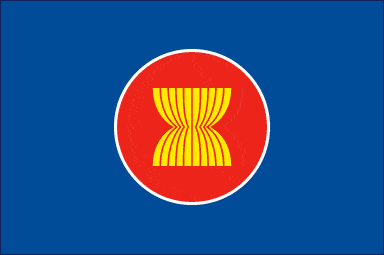Understanding ASEAN
ASEAN, or the Association of Southeast Asian Nations, was established on August 8, 1967, with the signing of the Bangkok Declaration. It aims to promote economic growth, social progress, cultural development, and regional peace among its member nations. ASEAN strives to foster collaboration and strengthen relationships, making it one of the most influential organizations in Southeast Asia.
The Creation of the ASEAN Flag
The ASEAN flag was officially adopted on July 24, 1997, during the 30th ASEAN Ministerial Meeting in Kuala Lumpur, Malaysia. The design was the result of a collaborative effort by the ASEAN Secretariat and the member countries. The flag’s creation marked a significant milestone in the organization’s history, as it symbolized the unity and shared aspirations of ASEAN.
Design and Symbolism of the Flag
The ASEAN flag consists of a blue background with a ten-pointed gold emblem at the center. The blue represents peace, stability, and the unity of ASEAN member states. The gold emblem, comprising ten rice stalks, symbolizes the richness and abundance of the region’s agriculture.
Colors and Their Meanings
The colors of the ASEAN flag hold symbolic significance. Blue represents peace, stability, and the importance of collaboration among member countries. Gold symbolizes prosperity, reflecting the economic potential and growth within the region. The harmonious combination of these colors conveys a message of unity and shared progress.
The Significance of the Emblem
The emblem on the ASEAN flag represents the spirit of togetherness among the member nations. The ten rice stalks symbolize the agricultural abundance and fertility of the region. Each stalk represents one of the ten founding member countries: Indonesia, Malaysia, Philippines, Singapore, Thailand, Brunei, Vietnam, Laos, Myanmar, and Cambodia.
The Power of Unity
The ASEAN flag serves as a reminder of the strength that lies in unity. It represents the shared goals, values, and aspirations of the member nations. By working together and fostering cooperation, ASEAN aims to create a better future for its people and promote regional stability and prosperity.
Celebrating ASEAN Day
Every year, on August 8th, ASEAN Day is celebrated to commemorate the founding of the organization. Member countries organize various events and activities to promote awareness of ASEAN’s achievements and foster a sense of community among their citizens. The ASEAN flag takes center stage during these celebrations, reminding everyone of the unity and shared destiny of the ASEAN community.
The Flag’s Influence and Recognition
The ASEAN flag has gained recognition globally as a symbol of regional cooperation and unity. It represents the collective voice of its member nations and serves as a visual representation of ASEAN’s commitment to peace, stability, and development. The flag’s distinct design and meaningful symbolism make it instantly recognizable and evoke a sense of pride among ASEAN citizens.
Promoting ASEAN Identity
The ASEAN flag plays a vital role in promoting ASEAN identity and fostering a sense of belonging among member countries. It serves as a unifying symbol that transcends borders, languages, and cultures, bringing together diverse nations under a shared vision of progress and prosperity. The flag serves as a constant reminder of the strength that lies in diversity.
The Flag as a Symbol of Progress
As ASEAN continues to grow and adapt to the changing global landscape, the flag represents the organization’s commitment to progress. It serves as a beacon of hope, inspiring member nations to work collectively towards sustainable development, economic integration, and social cohesion. The flag symbolizes ASEAN’s determination to overcome challenges and build a brighter future for its people.
Building Bridges through Cultural Exchange
The ASEAN flag also encourages cultural exchange among member countries. It serves as a catalyst for promoting understanding, appreciation, and respect for the diverse traditions, customs, and heritage of each nation. Through cultural exchange programs, ASEAN member countries foster mutual learning, strengthening the bonds of friendship and cooperation.
Strengthening Economic Cooperation
The ASEAN flag represents the economic potential within the region. It serves as a reminder of the shared commitment to regional economic integration, trade facilitation, and investment promotion. By working together, ASEAN member countries aim to harness their collective strength, drive economic growth, and enhance the livelihoods of their people.
Ensuring Peace and Stability
Peace and stability are fundamental to the vision of ASEAN. The flag symbolizes the organization’s dedication to resolving conflicts through peaceful means and promoting dialogue among member nations. By upholding the principles of non-interference, mutual respect, and peaceful coexistence, ASEAN strives to maintain peace and stability within the region.
Embracing Diversity within Unity
The ASEAN flag embodies the principle of unity in diversity. It acknowledges the rich tapestry of cultures, traditions, and ethnicities present within the member countries. The flag encourages inclusivity, reminding everyone that despite their differences, ASEAN member nations are bound together by shared values and a common purpose.
FAQs (Frequently Asked Questions)
1. What does the ASEAN flag symbolize? The ASEAN flag symbolizes unity, peace, and prosperity among the member countries. It represents the shared goals and aspirations of ASEAN in promoting regional stability, economic growth, and cultural exchange.
2. How many countries are members of ASEAN? ASEAN comprises ten member countries: Indonesia, Malaysia, Philippines, Singapore, Thailand, Brunei, Vietnam, Laos, Myanmar, and Cambodia.
3. What is the significance of the ten-pointed gold emblem on the flag? The ten-pointed gold emblem on the ASEAN flag represents the agricultural abundance and fertility of the region. Each stalk symbolizes one of the ten founding member countries.
4. When is ASEAN Day celebrated? ASEAN Day is celebrated on August 8th every year, commemorating the founding of the organization and promoting awareness of ASEAN’s achievements.
5. How does the ASEAN flag promote unity within diversity? The ASEAN flag acknowledges and celebrates the diverse cultures, traditions, and ethnicities within the member countries. It emphasizes the importance of embracing diversity while working towards a common goal of regional progress and prosperity.
Reference: Wiki

